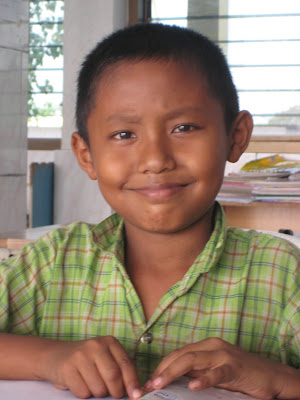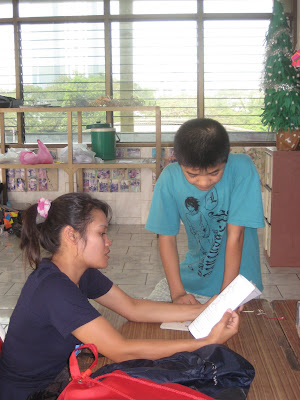


Bangkok, Wat Prok
This is Chai.
He is about eight years old. He is Mon, and came to Thailand with his parents.
I met him yesterday at Wat Prok, a lovely temple built and run by Mon Buddhists from Myanmar ( Burma ). Chai now lives there along with 50 or so other Mon boys. He was left here at the temple by his parents some time ago. It is common, according to the project director, Daniel, of a rudimentary school housed on the temple grounds, designed to teach the boys basic "three Rs" and some vocational skills, for parents to visit their children no more than a few times a year.
The boys are housed and fed by the Mon Buddhist monks. In the morning, they accompany the monks on their alms journey, assisting the monks with the food and drink that is given to them by the people in the community near the temple. The boys live in the temple complex, and sleep on mats in a large hall/ dormitory.
Many of the parents are working in canning factories south of Bangkok to eke out a living. Daniel said that they hope to return to their homeland, Myanmar ( Burma ) if the current repressive regime can be overturned.
I asked Daniel what these children, who are not allowed in Thai schools, would do when they were 16? He replied that often, the parents return for the boys when they are old enough to work. His hope is that the vocational skills--car repair, electronics basic skills--will give them a leg up in their village. So that via word of mouth, they will be called on to fix a motorbike engine or appliance.
The history of the Mon people, according to the University of Buffalo is as follows.
"The Mon are the earliest known inhabitants of lower Burma. They founded an empire, and introduced both writing and Buddhism into Burma.
In the year 573, two Mon brothers, Prince Samala and Prince Wimala, founded the Mon kingdom Hongsavatoi at the present site of modern Pegu. This kingdom flourished in peace and prosperity for several centuries until it was occupied by the Burman dynasty.
In 1757, the Burma ruler U Aungzeya invaded and devastated the Mon kingdom, killing tens of thousands of Mon, including learned Mon priests, pregnant women, and children. Over 3,000 priests were massacred by the victorious Burmans in the capital city alone. Thousands more priests were killed in the countryside.
The surviving priests fled to Thailand, and Burman priests took over the monasteries. Most of the Mon literature, written on palm leaves, was destroyed by the Burmans. Use of the Mon language was forbidden, and Burman became the medium of instruction.
Mon people were persecuted, oppressed, and enslaved, and countless people were burned in holocausts. Mon properties and possessions were looted and burned throughout Burma. Mons fled further south into Burma's Tenasserim Division and east into Thailand.
Unfortunately, the oppression of the Mon people has persisted to the present day."
Chai ( in Thai it means "yes" ) and I chatted for a bit while he was beginning to complete a page from a classroom workbook. He told me in very clear English his name and age. But most compelling were Chai's eyes. They were wizened for one so young.
So, what of Chai? What is his future?
Like so many stories of refugees--from Myanmar, from Sri Lanka, from African nations--there is no real answer. Thailand,
which has porous borders, is easy to enter, but not welcoming for most --even legal refugees.
Uncertainty is the norm for many, their refuge tentative, their future one stop short of hopeless.
MC
No comments:
Post a Comment